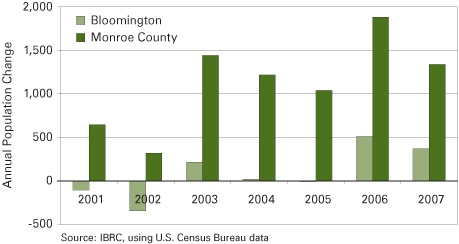Bloomington Forecast 2009
Director, Indiana Business Research Center, Kelley School of Business, Indiana University
November 2008
Just as 2009 promises to be a tough year for economies throughout the nation and around the world, it will challenge the Bloomington economy. The prospects for the Bloomington area, however, seem somewhat less cloudy than in many places, including much of Indiana.
On the bright side, the population of Bloomington and Monroe County continues to grow, and this in turn fuels businesses that serve the local market. As shown in Figure 1, both the city and the county have grown substantially over the past two years, and the city continues to account for a minority of total county growth. Monroe County gained an estimated 1,337 residents in 2007, its largest annual jump since the turn of the century and the fastest growth rate of any county in the region. Continued gradual population growth is expected in 2009.
Figure 1: Annual Population Change in Bloomington and Monroe County, 2001 to 2007

Growth of the overall economy of the Bloomington metropolitan statistical area (MSA) presents a mixed picture. The metro area's economic output (gross domestic product at the county level) grew 7.7 percent from 2001 through 2006 (the most recent year for detailed MSA data), but this was only half the national rate. The area's retail output grew more slowly than U.S. retail output, while its manufacturing output nearly equaled the national growth rate at 14.5 percent. Output of the professional and technical services sector gained a respectable 25.3 percent, outpacing the nation in this sector. In a preview of a general slowdown in building, output of the metro area's construction sector fell 12 percent in 2006 after five relatively steady years. The Bloomington area's output should end 2009 somewhere between flat and up very slightly (perhaps 1 percent) compared to 2008.
As this article was written, the Bloomington MSA appeared to be reaching a possible turning point in employment growth. For 2008 through September, payroll employment averaged more than 1,000 jobs above the same period in 2007. Job change in September and October, however, averaged a slight decrease. This workforce shrinkage was seen across a wide range of industries, more so in services than in goods production. One month of two does not make a trend, but given other signs of economic distress, it sharpens our focus on jobs figures for upcoming months. The outlook for 2009 calls for growth of about 500 jobs overall.
Monroe County manufacturing employment in the first quarter of 2008 was up by 139 jobs compared to a year earlier; chemical manufacturing (which includes pharmaceutical products) was up 271 jobs. As shown in Figure 2, despite some ups and downs, the county's manufacturing employment has followed a generally upward trend for about three years—gradual growth that's very welcome after years of significant declines. Over the past year, however, factory wages have slipped by $27 per week—a small but noticeable decline evident in Figure 2. For the year ahead, manufacturing should hold its own in Monroe County with regard to jobs, while wages will still be under modest downward pressure.
Figure 2: Monroe County Manufacturing Jobs and Real Wages, 2001:1 to 2008:1

The Bloomington MSA's per capita personal income (PCPI) continued its long-term deficit relative to the United States, with 2007 PCPI only 74.3 percent of the national figure. The long-term loss of well-paying manufacturing jobs is a significant contributor to this slippage, a phenomenon that plagues the state as well. Though local PCPI will continue to grow in an absolute sense, our incomes are not likely to close the gap with the nation in the coming year.
Finally, the local area's housing market has been slowing down recently, but it's not nearly as weak as in many parts of the country. Residential home sales for 2008 through September were down about 11 percent compared to the same period in 2007, while home prices were down about 2 percent. Time on the market has also risen from 105 to 130 days, and more foreclosed homes are available on the market now. Demand is pretty good for houses in the $100,000 to $250,000 range, but weak for higher-priced homes. As elsewhere, financing is available but limited to buyers with strong credit ratings and equity to bring to the purchase. The local real estate outlook may represent a ray of light toward the end of 2009 as credit markets loosen up and the remaining surplus of houses fills increasing demand. However, actions yet to be determined by the federal government could greatly affect prospects for a housing turnaround in the Bloomington area.
Also in this Issue…
- Outlook for 2009
- International Outlook for 2009
- U.S. Outlook for 2009
- Financial Outlook for 2009
- Housing Market Outlook for 2009
- Indiana's Outlook for 2009
- Indiana's Agricultural Outlook for 2009
- Indiana's Special Sectors Outlook for 2009
- Anderson Forecast 2009
- Bloomington Forecast 2009
- Columbus Forecast 2009
- Evansville Forecast 2009
- Fort Wayne Forecast 2009
- Gary Forecast 2009
- Indianapolis-Carmel Forecast 2009
- Kokomo Forecast 2009
- Louisville Forecast 2009
- Muncie Forecast 2009
- Richmond Forecast 2009
- South Bend and Elkhart Area Forecast 2009
- Terre Haute Forecast 2009
- Return to Table of Contents



